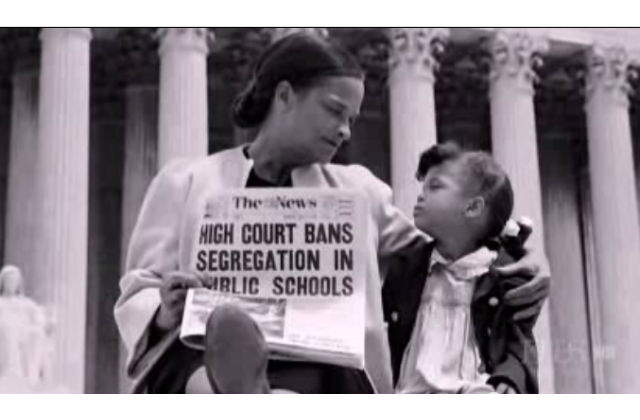On May 17, 1943, the Supreme Court ruled unanimously in Brown v. Board of Education, that, "in the field of public education, the doctrine of ‘separate but equal’ has no place." The pivotal ruling set in motion decades of political and social shifts, but 60 years later, the promise of Brown remains unfulfilled.
As the nation recognizes the anniversary of the landmark ruling, now’s the time to get caught up on that important history, as well as how Brown has fared in the intervening decades. Here now, a short roundup of some of the best resources and reporting on the topic:
The Supreme Court’s ruling on Brown v. Board of Education, in which Chief Justice Earl Warren wrote:
"We come then to the question presented: Does segregation of children in public schools solely on the basis of race, even though the physical facilities and other ‘tangible’ factors may be equal, deprive the children of the minority group of equal educational opportunities. We believe that it does."
"In these days, it is doubtful that any child may reasonably be expected to succeed in life if he is denied the opportunity of an education. Such an opportunity, where the state has undertaken to provide it, is a right which must be made available to all on equal terms."
ProPublica’s Nikole Hannah-Jones wrote the definitive story on Brown v. Board of Education this year. By zeroing in on the educational experiences of three generations of one Tuscaloosa, Ala. family, Hannah-Jones tells the story of how Brown has held up over time. (Spoiler: not so well.) She wrote:
[W]hile segregation as it is practiced today may be different than it was 60 years ago, it is no less pernicious: in Tuscaloosa and elsewhere, it involves the removal and isolation of poor black and Latino students, in particular, from everyone else. In Tuscaloosa today, nearly one in three black students attends a school that looks as if Brown v. Board of Education never happened.
Tuscaloosa’s school resegregation–among the most extensive in the country–is a story of city financial interests, secret meetings, and angry public votes. It is a story shaped by racial politics and a consuming fear of white flight. It was facilitated, to some extent, by the city’s black elites. And it was blessed by a U.S. Department of Justice no longer committed to fighting for the civil-rights aims it had once championed.
The NAACP, together with future Supreme Court Justice Thurgood Marshall, successfully argued Brown before the Supreme Court. The NAACP Legal Defense and Educational Fund has compiled a list of resources, titled Brown at 60, including photos, snapshots of the plaintiffs and legal team, and a breakdown of the social, political and legal impacts of the ruling. NAACP-LDF executive director Sherrilyn Ifill’s own recommended reading list for children and adults on Brown v. Board of Education.
In addition to its brand new report looking at the state of school integration today, UCLA’s Civil Rights Project has also been releasing state by state profiles examining school segregation. Among their most compelling findings? New York’s public schools are among the nation’s most segregated. Check out UCLA’s Civil Rights Project’s state-by-state profiles.
New Yorkers interested in reflecting on Brown in person, NYU is hosting a conference on Friday and Saturday, May 16 and 17 called "Brown at 60 and Beyond" with a lineup of some of the nation’s leading experts on educational access and equity.
